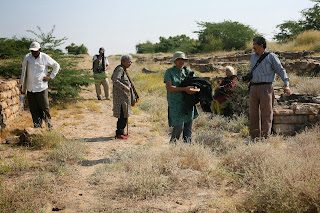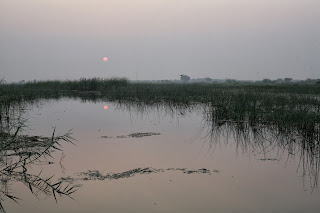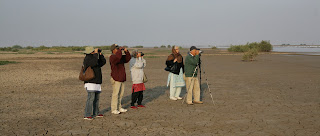During
the five-week excavation season at Ghor al-Safi, most days were routine, but on some days we
did special things.
On
the afternoon of Monday December 2, the dig team went to Amman after work to
attend an archaeology lecture at the National Museum. Afterwards we were joined
by Isabelle Rubin, a Lot’s Cave veteran, for dinner at the Books@Cafe
restaurant on Rainbow Street. That trip was fine, except for the fact that I came
down with food poisoning from the restaurant food and threw up early the next
morning, the first time I have thrown up in well over a decade. I took off work
that next day, the only lost workday for anybody on the team that season.
On
the first two Fridays I joined the group on trips to sites in the vicinity. The
first Friday we went to the nearby Roman farmstead at Bulayda where Alex had
excavated some ten years ago.
Alex
showing us the Roman farmstead at Bulayda
The
next weekend we went to see an ancient cemetery in Ghor al-Safi that was being
actively robbed out, including one grave the previous night.
The
cemetery that is being actively robbed out
We
then went to the nearby Roman fort of Umm al-Tawabin on the top of the highest
nearby hill.
Dino
surveying Ghor al-Safi and the south end of the Dead Sea from the top of Umm
al-Tawabin
The
landscape around Umm al-Tawabin
Jamila,
our representative from the Department of Antiquities for the first half of the
season, invited us to her home for dinner one day.
Jamila
with Dino and Alex at her dinner
December
24 was the last day of field work with all the workmen. The workmen at the sugar factory prepared a
special feast that day for the 10:30 break.
The
workmen with Alex and Ana and the special feast the workmen had prepared
After
the full workday, we had a Christmas Eve party in the museum galleries that
evening. The night guard did not like alcohol being served, so he called the
museum director and district inspector for the Department of Antiquities who
came and kicked us out of the galleries. The group simply continued the party
in our living quarters one floor down.
The
group in the museum galleries on Christmas Eve with the newly discovered
chancel screen post.
December
25 I spent a full day at the site, taking final photographs and elevations.
That afternoon we had a Christmas banquet back at the museum.
The
Christmas banquet
After
the field work ended, I spent the next three days doing post-season notebook
work at the museum, before we all left on the morning of December 29 and I
moved back in at ACOR.



















































